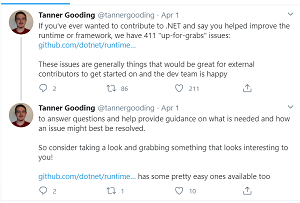News
.NET Team Developer Seeks Help for Easy 'Up-for-Grabs' Issues
.NET coder? Have some free time? Ever wonder about helping out with open source? Want to get started on some low-hanging fruit?
If you can check off all those, Tanner Gooding has a deal for you.
The developer on the .NET Libraries team, working on Hardware Intrinsics and Numerics, tweeted the following yesterday (April 1):
"If you've ever wanted to contribute to .NET and say you helped improve the runtime or framework, we have 411 'up-for-grabs' issues: https://github.com/dotnet/runtime/issues?q=is%3Aopen+is%3Aissue+label%3Aup-for-grabs
These issues are generally things that would be great for external contributors to get started on and the dev team is happy to answer questions and help provide guidance on what is needed and how an issue might best be resolved.
So consider taking a look and grabbing something that looks interesting to you!
https://github.com/dotnet/runtime/issues?q=is%3Aopen+is%3Aissue+label%3Aup-for-grabs+label%3Aarea-System.Numerics has some pretty easy ones available too"
Or, for graphically oriented readers:
 [Click on image for larger view.] The Tweet (source: Twitter).
[Click on image for larger view.] The Tweet (source: Twitter).
The 411 issues run the gamut of areas, ranging from System.Numerics to CoreLib-mono to Setup, with a particularly low-hanging item in the latter area reading: "Rename ThirdPartyNotices.txt to THIRD-PARTY-NOTICES.txt" (something even this reporter might be able to muster up on a good day).
Doing some simple sorting on the 411 issues reveals the following:
- The most-commented issue among the 411 open items reads: "Collection<T> and ObservableCollection<T> do not support ranges," opened on Aug. 13, 2016.
- The issue with the most "thumbs-up" reactions reads: "Support System.DirectoryServices.Protocols on Linux/Mac," opened Oct. 24, 2017.
- The newest issue reads: "System.Numerics.Matrix4x4.Invert has no SIMD acceleration," opened April 1.
- The oldest issue reads: "String comparer for sorting numeric strings logically," opened Jan. 11, 2015.
- The least recently updated issue reads: "need way to configure per-test xunit attributes," opened Nov. 22, 2016.
In response to a question about helping out with a specific issue, Gooding tagged the owners for its area and pointed to this list of areas and their owners for the runtime project.
About the Author
David Ramel is an editor and writer at Converge 360.